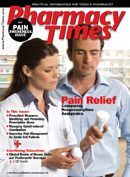Publication
Article
Pharmacy Times
REMS and Opiates- A New Beginning?
Author(s):
John Burke, commander of the Warren County, Ohio, drug task force and retired commander of the Cincinnati Police Pharma ceutical Diversion Squad, is a 40-year veteran of law enforcement. Cmdr Burke also is the current president of the National Associ ation of Drug Diversion Investigators. For information, he can be reached by email at [email protected], via the Web site www.rxdiversion.com, or by phone at 513-336-0070.

The FDA’s decision to require manufacturers to develop Risk Evaluation and Mitigation Strategies (REMS) for their new or improved prescription opiates has had a widespread effect on these companies and their plans for distributing their pain relievers. As these companies scramble to develop REMS that will receive FDA approval and allow their products to be approved for distribution, many questions are generated as to exactly what the federal agency wants them to achieve and how to do it.
Of course, REMS for opiates have been mandated due to the continued rise in prescription drug abuse in our country. Some of this abuse is intentional, and some of it is accidental; nonetheless, the FDA is requiring some new ideas and strategies in an attempt to reduce this diversion problem in America. For the first time, generic pharmaceutical companies are also included in this mandate; branded companies feel that this is long overdue.
The basic truth is that the generic drugs that effectively treat pain are also the best drugs to abuse for the optimum high. Hydrocodone, oxycodone, oxymorphone, morphine, fentanyl, and hydromorphone are at the top of the food chain for those who abuse prescription opiates. The goal for many of the extended-release opiates is to provide effective, long-lasting pain relief, with a mechanism that severely impairs the abuser from obtaining his or her drug of choice.
Manufacturers have spent millions of dollars on trying to either find a formulation that will cause the abuser to become ill if they try to extract the drug by not taking it as directed or provide a pharmaceutical that is virtually impossible to abuse. Whereas the most hardened abusers will either snort or inject these opiates to get high, one of the goals is to make this practice with the new opiates undesirable.
The concern is always present that prescription opiate abusers will develop a new technique that will successfully bypass whatever safeguard the companies have employed in their new products. This has happened in the past, and the hope is that these new products will truly be better at combating diversion. History has shown that only time will tell, as some products have been on the market for years before the drug-seeking population discovered that the drugs could be successfully abused.
Without putting these products on the market and available to the vast majority of users (legitimate patients), however, the efficacy and abuse potential will not be truly known. In the meantime, my concern is that a segment of the pain population is continuing to go without proper pain relief.
I commend the FDA for tackling this problem, but I am also hoping that they give the opiate manufacturers a clear vision as soon as possible as to what they need to accomplish in order to market their drug. Manufacturers certainly have a lot of money invested and therefore need to begin their marketing process, but thoughtful consideration of the pain patient should also be on the minds of these manufacturers as they develop the guidelines for REMS.
Law enforcement and the National Association of Drug Diversion In - vestigators certainly support the effort made by the FDA to create guidelines to provide better safety to the public in this matter, but we also applaud the many manufacturers that are trying hard to produce an abuse-resistant opiate. A lot is at stake here—mainly patients—so let’s hope that the FDA process speeds up this fall, and we all see products that create significant reduction in pain and drug diversion.

Newsletter
Stay informed on drug updates, treatment guidelines, and pharmacy practice trends—subscribe to Pharmacy Times for weekly clinical insights.






